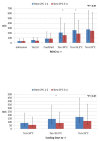Relationship between time to target temperature and outcome in patients treated with therapeutic hypothermia after cardiac arrest
- PMID: 21439038
- PMCID: PMC3219373
- DOI: 10.1186/cc10116
Relationship between time to target temperature and outcome in patients treated with therapeutic hypothermia after cardiac arrest
Abstract
Introduction: Our purpose was to study whether the time to target temperature correlates with neurologic outcome in patients after cardiac arrest with restoration of spontaneous circulation treated with therapeutic mild hypothermia in an academic emergency department.
Methods: Temperature data between April 1995 and June 2008 were collected from 588 patients and analyzed in a retrospective cohort study by observers blinded to outcome. The time needed to achieve an esophageal temperature of less than 34°C was recorded. Survival and neurological outcomes were determined within six months after cardiac arrest.
Results: The median time from restoration of spontaneous circulation to reaching a temperature of less than 34°C was 209 minutes (interquartile range [IQR]: 130-302) in patients with favorable neurological outcomes compared to 158 min (IQR: 101-230) (P < 0.01) in patients with unfavorable neurological outcomes. The adjusted odds ratio for a favorable neurological outcome with a longer time to target temperature was 1.86 (95% CI 1.03 to 3.38, P = 0.04).
Conclusions: In comatose cardiac arrest patients treated with therapeutic hypothermia after return of spontaneous circulation, a faster decline in body temperature to the 34°C target appears to predict an unfavorable neurologic outcome.
Figures

Comment in
-
Therapeutic hypothermia post out-of-hospital cardiac arrest - more questions than answers?Crit Care. 2011;15(2):151. doi: 10.1186/cc10123. Epub 2011 Apr 15. Crit Care. 2011. PMID: 21542884 Free PMC article.
-
Is faster still better in therapeutic hypothermia?Crit Care. 2011;15(3):162. doi: 10.1186/cc10234. Epub 2011 Jun 1. Crit Care. 2011. PMID: 21672273 Free PMC article.
References
-
- Holzer M, Cerchiari E, Martens P, Roine R, Sterz F, Eisenburger P, Havel C, Kofler J, Oschatz E, Rohrbach K, Scheinecker W, Schörkhuber W, Behringer W, Zeiner A, Valentin A, De Meyer M, Takunen O, Tiainen M, Hachimi-Idrissi S, Huyegens L, Fischer M, Walger P, Bartsch A, Födisch M, Bonnizoli M, Pagni E, Kaff A, Schneider B, Müllner M. Mild therapeutic hypothermia to improve the neurologic outcome after cardiac arrest. N Engl J Med. 2002;346:549–556. doi: 10.1056/NEJMoa012689. - DOI - PubMed
-
- Kim F, Olsufka M, Longstreth WT Jr, Maynard C, Carlbom D, Deem S, Kudenchuk P, Copass MK, Cobb LA. Pilot randomized clinical trial of prehospital induction of mild hypothermia in out-of-hospital cardiac arrest patients with a rapid infusion of 4 degrees C normal saline. Circulation. 2007;115:3064–3070. doi: 10.1161/CIRCULATIONAHA.106.655480. - DOI - PubMed
Publication types
MeSH terms
LinkOut - more resources
Full Text Sources
Other Literature Sources
Medical
Miscellaneous

